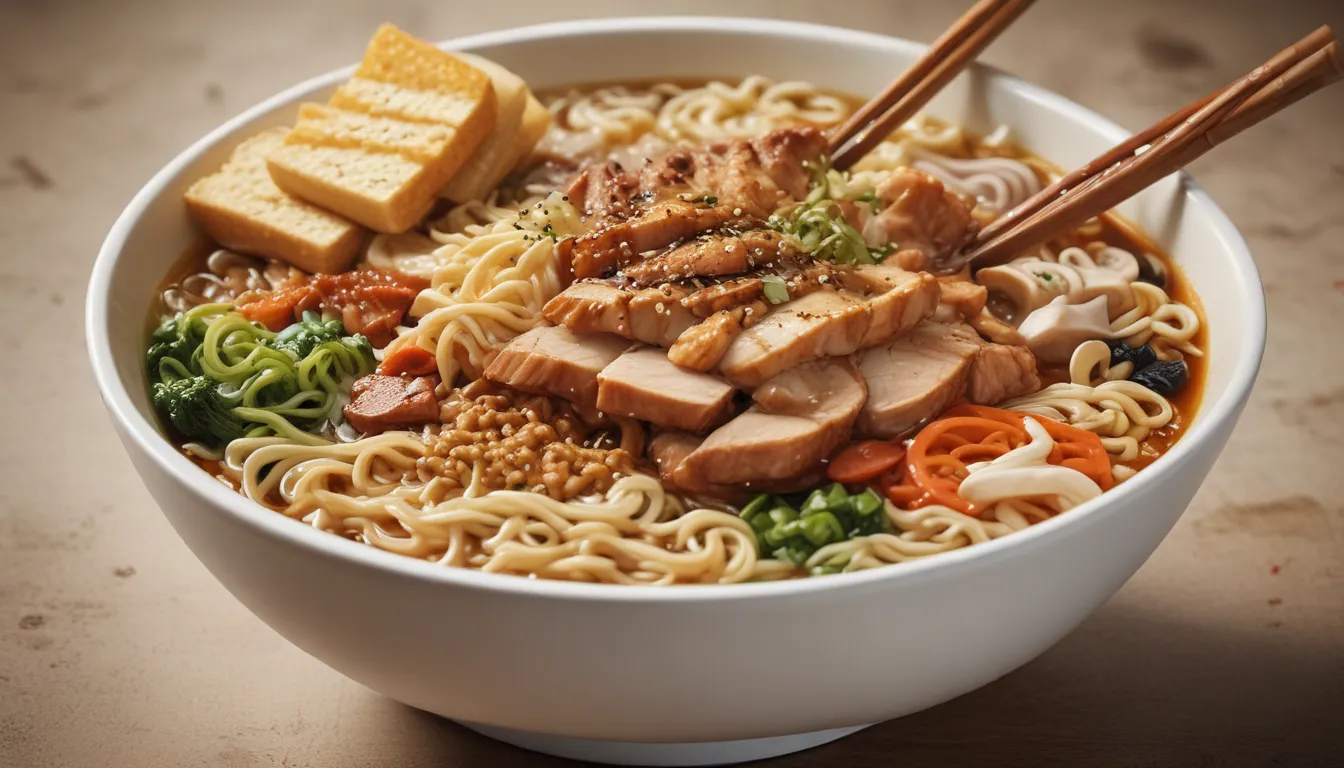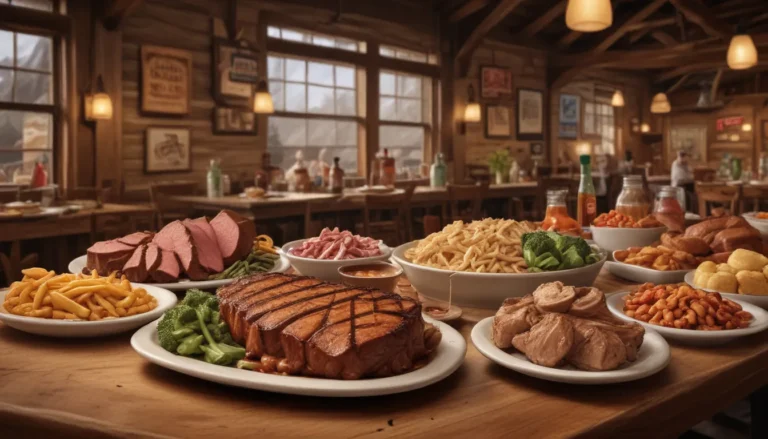The pictures in our articles might not always show exactly what the text is talking about. We use these images to make the article more interesting and eye-catching. They are there to add to the text, but not to replace it or show every detail.
Welcome to the enticing world of ramen, where a humble bowl of noodles in savory broth has captured the hearts and taste buds of people worldwide. Originating in Japan, ramen has evolved into a culinary masterpiece, blending tradition with innovation. In this comprehensive guide, we'll delve into 18 fascinating facts about ramen, from its origins to its cultural significance, ingredients, and more.
The Origins and Evolution of Ramen
Ramen's roots can be traced back to China, where it was known as "la-mian" or "pulled noodles." In the early 20th century, Japanese noodle vendors embraced this dish and adapted it to suit local tastes, giving birth to what we now know as ramen.
Ramen Noodles: A World of Variety
Ramen noodles come in various shapes and sizes, offering a diverse range of textures to complement different broth types. From thin and delicate to thick and chewy, each style adds a unique dimension to the overall ramen experience.
The Art of Crafting Flavorful Broth
A key element of ramen lies in its flavorful broth, which can be made from chicken, pork, beef, seafood, or vegetarian ingredients. The complexity and depth of flavor in the broth often result from hours of simmering bones, vegetables, and aromatic spices.
The Ramen Trifecta: Noodles, Broth, and Toppings
A classic ramen bowl consists of three essential components: noodles, broth, and toppings. The harmonious combination of these elements determines the overall taste experience and creates a symphony of flavors and textures.
Regional Ramen Specialties: A Culinary Journey Across Japan
Japan boasts a diverse range of regional ramen styles, each with its distinct characteristics. From Sapporo's miso-based ramen to Tokyo's soy sauce-based variation, Hakata's tonkotsu-based ramen, and Kitakata's shoyu-based version, each city offers a unique twist on this beloved dish.
Instant Ramen: A Culinary Revolution
In 1958, Momofuku Ando revolutionized the culinary world with the introduction of instant ramen. This convenient and long-lasting meal option gained immense popularity globally, becoming a staple in households around the world.
Exploring the Shin-Yokohama Ramen Museum
Yokohama, Japan, is home to the Shin-Yokohama Ramen Museum, a dedicated space showcasing the rich history and diverse flavors of ramen. Visitors can immerse themselves in the world of ramen, explore various ramen shops, learn about its evolution, and even create their custom noodles.
The Healthy Side of Ramen
Contrary to popular belief, ramen can offer nutritional benefits when balanced with fresh vegetables and protein. The broth provides essential minerals and amino acids, while the noodles offer a source of carbohydrates, making ramen a well-rounded meal option.
Ramen Toppings: Elevating the Flavor Profile
Ramen is often adorned with an array of mouthwatering toppings like chashu, soft-boiled eggs, seaweed, bamboo shoots, and green onions. These additions elevate the flavors and textures of the dish, creating a delightful culinary experience.
Ramen in Pop Culture: A Symbol of Comfort and Excellence
Ramen has cemented its status as a symbol of comfort, nostalgia, and culinary excellence in pop culture. It has been featured in numerous films, manga, and anime, captivating audiences worldwide with its allure.
Competitive Ramen Eating: A Display of Speed and Appetite
In Japan, ramen eating competitions showcase contestants battling it out to consume colossal amounts of ramen in record time. These events highlight the incredible speed and voracious appetites of participants, showcasing the love and passion for this beloved dish.
The Ramen Rating System: Evaluating the Best Bowls
Diners and ramen enthusiasts often use a rating system called the "ramen scale" to evaluate and compare different ramen shops. Factors like broth richness, noodle texture, and overall experience contribute to the rating, helping diners discover the best bowls in town.
Ramen as a Hangover Cure: Restoring Balance and Vitality
Ramen is renowned as a go-to remedy for hangovers in Japan, thanks to its nourishing broth, hydrating noodles, and comforting toppings. This satisfying meal helps revitalize the body and restore balance after a night of indulgence.
Embracing Unique Ramen Variations
Chefs worldwide have embraced ramen as a canvas for their creativity, offering unique variations like cheese ramen, chocolate ramen, and vegan ramen. These innovative twists provide a delightful take on the classic dish, appealing to adventurous food enthusiasts.
Celebrating Ramen at Festivals
Ramen festivals in Japan attract crowds of food enthusiasts eager to sample a wide range of ramen styles from different regions. These vibrant events celebrate the diversity of flavors and the craftsmanship of ramen chefs, offering a culinary adventure for visitors.
Embracing Ramen Etiquette: Slurping and Savory Delights
In Japan, slurping your noodles while eating ramen is not only acceptable but encouraged. This act is believed to enhance the flavors and show appreciation for the chef's efforts, adding to the overall dining experience.
Ramen’s Global Impact: Bridging Culinary Traditions
Ramen's influence has transcended borders, becoming a symbol of cross-cultural exchange and culinary fusion. It captivates people of all backgrounds, showcasing the universal appeal and versatility of this beloved dish.
In Conclusion: The Legacy of Ramen
Ramen, with its rich history, enticing flavors, and universal appeal, continues to enthrall food enthusiasts worldwide. Whether you savor a traditional bowl or explore modern variations, the allure of ramen is certain to leave a lasting impression. Join us as we celebrate the legacy of ramen and embark on a flavorful journey through its diverse flavors and cultural significance.
Frequently Asked Questions (FAQs) About Ramen
Is ramen gluten-free?
While traditional ramen noodles are made from wheat flour and are not gluten-free, some restaurants and stores offer gluten-free alternatives made from rice or buckwheat.
Can vegetarians and vegans enjoy ramen?
Absolutely! Many ramen establishments now offer vegetarian and vegan options, featuring vegetable-based broths and plant-based protein alternatives like tofu.
How do you eat ramen properly?
To enjoy ramen to the fullest, use chopsticks to pick up the noodles, bring them to your mouth, and slurp them. Sip the broth between noodle bites and savor the harmonious flavors of the toppings.
What are the healthiest ramen choices?
Opt for ramen bowls with lighter broths like miso or shoyu (soy sauce) and add extra vegetables and lean protein to make it a more nutritious meal option.
Can I make ramen at home?
Yes! Making ramen at home can be a fun and rewarding experience. There are plenty of recipes and tutorials available online to guide you through preparing homemade ramen broth and assembling your own delicious bowl.
As you embark on your journey through the rich and flavorful world of ramen, we hope this guide enhances your understanding and appreciation for this iconic dish. Whether you're a ramen aficionado or a curious food enthusiast, there's always something new and exciting to discover in the realm of ramen. So, grab your chopsticks, slurp up some noodles, and savor the delightful taste of this beloved culinary treasure.






